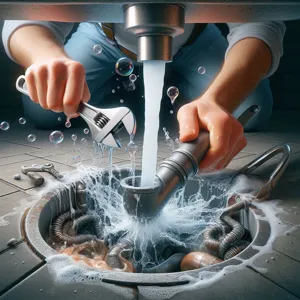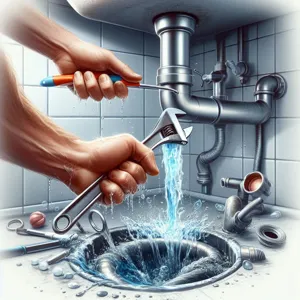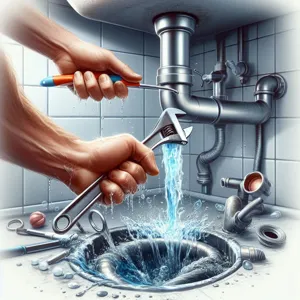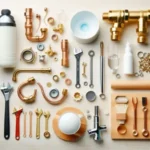Dealing with a clogged drain can be a frustrating ordeal that disrupts your daily routine and causes unnecessary stress.
Whether it’s the slow trickle of water in your sink or a complete blockage in your shower, these pesky plumbing issues can quickly escalate if not addressed promptly. Fortunately, you don’t always have to call in a professional to resolve the problem. With a little know-how and some handy household items, you can tackle minor clogs right from the comfort of your home. In this blog post, we’ll explore ten effective methods to unclog your drain, ranging from simple DIY techniques to natural remedies that are safe for your plumbing. Say goodbye to the hassle of standing water and hello to smooth-flowing drains as we guide you through these practical solutions that every homeowner should have in their toolkit!
1. Understanding the Common Causes of Clogged Drains

Understanding the common causes of clogged drains is essential for addressing the issue effectively and preventing future blockages. While it may seem like an inconvenience that comes out of nowhere, clogged drains often result from a series of predictable culprits that can build up over time.
One of the most common offenders is hair. Whether it’s long strands from a shower or tiny strands from a bathroom sink, hair can easily accumulate in your pipes, creating a tangled mess that restricts water flow. In kitchens, food debris is a frequent culprit. Small bits of grease, oil, and leftover food particles can combine to create a sticky sludge that clings to the insides of your pipes, gradually narrowing the passageway until water can no longer flow freely.
Another hidden menace is soap scum, particularly in bathrooms. Traditional soaps can leave behind residues that collect over time, especially when mixed with minerals found in hard water. Similarly, mineral buildup from hard water can create scale deposits, further constricting your pipes.
Roots from nearby trees are another common cause of drain issues, as they can invade your home’s plumbing system in search of moisture and nutrients. Once roots find their way into the pipes, they can grow and cause significant blockages.
Lastly, foreign objects—like cotton swabs, dental floss, and even toys—often make their way into drains, leading to unexpected clogs. Understanding these common causes is the first step in taking proactive measures to keep your drains clear and flowing smoothly. By being aware of what can lead to blockage, you can implement preventive practices and be better prepared to tackle any issues that arise.
2. Method 1: Boiling Water to the Rescue
When faced with a sluggish drain, the simplest solution may often be the most effective: boiling water. This time-honored method is not only easy but also requires no special tools or expensive products. Here’s how it works.
Start by bringing a large pot of water to a rolling boil. The ideal temperature is just below boiling point—around 212°F (100°C)—which will help dissolve the grease and grime that often contribute to drain clogs. Carefully pour the boiling water directly into the drain in a slow, steady stream. This allows the heat to penetrate deeper into the blockage, breaking down any stubborn buildups of soap scum, hair, or food particles.
For optimal results, repeat this process two or three times, allowing a few moments in between each pour. The heat from the water will not only melt away the debris but also help flush it through the pipes, promoting a clearer flow.
While boiling water can be a great first step for minor clogs, it’s essential to use caution, especially if you have PVC pipes, as excessive heat may cause damage. If you suspect your clog is more severe or has been lingering for an extended period, it might be time to explore additional methods. However, in many cases, this simple technique can work wonders, leaving your drains flowing freely and your home feeling fresh. So, before reaching for harsher chemicals, give boiling water a chance to work its magic—your drains will thank you!
3. Method 2: Baking Soda and Vinegar Solution

When it comes to tackling stubborn clogs, the dynamic duo of baking soda and vinegar is a powerful, eco-friendly solution that many homeowners swear by. This method not only helps clear your drains but also offers a gentle cleanse for your plumbing system, making it an ideal choice for regular maintenance.
To begin, gather your materials: a box of baking soda, a bottle of white vinegar, and a kettle of boiling water. This simple household combination works as a natural chemical reaction that can dissolve grime, grease, and debris.
Start by pouring about a cup of baking soda directly into the clogged drain. Ensure it’s as close to the source of the blockage as possible. Follow this with a cup of white vinegar; you’ll hear a satisfying fizzing sound as the two ingredients react. This effervescent reaction creates bubbles that work to break down stubborn build-up within the pipes, loosening anything that might be causing the blockage.
Allow the mixture to sit undisturbed for about 30 minutes. During this time, the powerful combination of baking soda and vinegar is doing its job, breaking down clogs and deodorizing your pipes. For particularly stubborn clogs, you can let it sit for up to an hour for maximum effect.
After the waiting period, boil a kettle of water and carefully pour it down the drain. This final step flushes away the loosened debris, leaving your pipes clear and fresh. Not only is this method effective, but it’s also safe for your plumbing and the environment, making it a go-to for those looking to maintain a healthy home without resorting to harsh chemicals.
So, next time you face a sluggish drain, remember this baking soda and vinegar solution—it’s a simple, natural remedy that can save you time and money while keeping your plumbing system in top shape.
4. Method 3: The Power of a Plunger
When it comes to tackling stubborn clogs, few tools are as iconic and effective as the trusty plunger. Often overlooked, this simple device can be your first line of defense against blocked drains, whether in the kitchen sink, bathroom, or even the toilet.
To use a plunger effectively, begin by ensuring there’s enough water in the basin to cover the rubber cup completely. This water creates the necessary seal for maximum suction. Position the plunger over the drain, aligning it so that the cup fully envelops the opening. Apply firm, steady pressure as you push down to expel air, followed by an equally vigorous pull to create suction. Repeat this motion several times—typically, a good rhythm of 15 to 20 plunges should suffice.
The power of a plunger lies in its ability to generate pressure that can dislodge stubborn blockages. Whether it’s a buildup of hair, grease, or food particles, the force created can often break up the clog, allowing water to flow freely once again. After several attempts, remove the plunger and watch as the water begins to drain away; if it does, you’ve successfully cleared the blockage!
However, if the water doesn’t budge, don’t despair. Sometimes, stubborn clogs require a bit more finesse. Consider using the plunger in conjunction with hot water or a mixture of baking soda and vinegar for a more robust approach. Nonetheless, the plunger remains a vital tool in your plumbing arsenal, embodying the essence of DIY home remedies—simple, effective, and always ready to tackle the unexpected hiccups of household maintenance.
5. Method 4: Using a Drain Snake

When it comes to clearing stubborn clogs, a drain snake is one of the most effective tools in your arsenal. A drain snake, also known as a plumber’s snake or auger, is a long, flexible tool designed to navigate the twists and turns of your plumbing system, reaching deep into the pipes to dislodge blockages that simple plungers can’t reach.
To use a drain snake, start by removing the drain cover or stopper from the affected sink or tub. Insert the end of the snake into the drain, and gently push it down the pipe while rotating the handle. You’ll want to apply slight pressure as you maneuver the snake deeper, feeling for resistance that indicates the location of the clog. Once you encounter the blockage, continue twisting the snake to break it up or hook it, pulling it back toward you.
It’s important to be patient during this process; sometimes, you may need to repeat the insertion and rotation several times before you fully clear the debris. Once you believe the clog has been dislodged, run hot water down the drain to flush any remaining particles and ensure proper flow.
Using a drain snake can be a bit messy, so be sure to have towels or a bucket handy to catch any residual water or debris that may spill out during the process. With a little persistence and the right technique, a drain snake can save you from costly plumbing bills and restore peace to your home’s drainage system.
6. Method 5: Wet/Dry Vacuum Magic
When it comes to tackling stubborn clogs, the wet/dry vacuum proves to be an unsung hero in the realm of home maintenance. This versatile tool, often hiding in garages or utility rooms, can work wonders for your drains when traditional methods fail.
To harness the magic of a wet/dry vacuum, start by ensuring it’s set to the liquid setting. If your vacuum has a filter, make sure it’s designed for wet use; otherwise, you might find yourself with a messy cleanup. Next, create a tight seal over the drain. This can often be achieved by using the vacuum hose to cover the opening completely, ensuring no air escapes. If the clog is located in a sink or shower, you might find it helpful to use a wet cloth or duct tape to further seal the edges—this will enhance the vacuum’s suction power.
Once everything is set, turn the vacuum on to its highest setting. The suction should pull the obstruction up and out of the drain, making it a surprisingly effective solution for hair, food particles, and other debris that tends to build up over time. For deeper clogs, you may need to alternate between the vacuum’s suction and a bit of water, allowing the powerful pull to break loose and extract the blockage.
Remember to empty the vacuum reservoir as needed, especially if the clog is particularly large or the tank fills quickly. Once you’ve successfully removed the blockage, follow up with a hot water rinse down the drain to flush away any lingering residue.
Using a wet/dry vacuum not only saves you from harsh chemicals but also offers a quick and environmentally friendly method to reclaim your drains. So next time you find yourself facing a stubborn clog, don’t underestimate the power of this handy tool—it might just work magic in restoring your plumbing flow!
7. Method 6: Salt and Hot Water Treatment

Method 6: Salt and Hot Water Treatment
If you’re facing a stubborn clog, the combination of salt and hot water may just be the remedy your drains need. This simple yet effective method harnesses the natural properties of salt to break down buildup in your pipes while the hot water acts as a catalyst to enhance the process.
To start, gather about half a cup of coarse salt—table salt will work in a pinch, but coarse salt is preferable due to its larger granules, which can provide a scrubbing effect. Pour the salt directly down the drain, ensuring it reaches the areas where the clog is most likely situated. Next, heat a pot of water until it reaches a rolling boil.
Once the water is hot, carefully pour it down the drain over the salt. You’ll want to do this in stages, allowing the hot water to work its magic on the salt before adding more. The heat helps dissolve grease and food particles, while the salt aids in breaking apart stubborn debris clinging to the sides of your pipes.
This method is especially effective for kitchens where greasy buildup is common. After pouring the hot water and salt mixture, let it sit for about 15 minutes to allow the solution to penetrate and break down the clog. Follow this with a final flush of hot water to rinse away any remaining debris and salt.
This treatment is not only eco-friendly but also an inexpensive alternative to chemical drain cleaners. Regularly using this method can help maintain clear drains and prevent future clogs, ensuring that your plumbing system remains in good health. So, the next time you notice slow drainage, reach for the salt and hot water—it might just be the perfect solution!
8. Method 7: Enzyme Cleaners Explained
When it comes to tackling stubborn clogs, enzyme cleaners offer a powerful, eco-friendly alternative to traditional chemical drain cleaners. These unique products harness the natural power of enzymes and bacteria to break down organic material, such as hair, grease, soap scum, and food particles, that often contribute to blockages in your plumbing system.
Unlike harsh chemicals that can corrode your pipes and release toxic fumes into your home, enzyme cleaners are gentle yet effective. They work by introducing specific strains of bacteria into your drain that feed on the organic waste, effectively digesting it and clearing the obstruction over time. This means that while you might not see immediate results as you would with a chemical cleaner, enzyme cleaners provide a more sustainable solution that can help maintain the health of your plumbing.
Using enzyme cleaners is simple. Just pour the recommended amount down your drain, and let it sit for several hours or overnight, allowing the enzymes to get to work. For best results, it’s beneficial to use these cleaners regularly—perhaps once a month—to prevent buildup and keep your drains flowing smoothly.
In addition to being safe for your pipes and the environment, enzyme cleaners are also a great option for homes with septic systems, as they help maintain the balance of beneficial bacteria essential for proper septic function. So, if you’re looking for an effective and responsible way to unclog your drains, consider giving enzyme cleaners a try. They not only clear your drains but also promote a healthier plumbing system, making them an invaluable tool in your home maintenance arsenal.
9. Method 8: Cleaning the Trap
Cleaning the trap is often an overlooked yet vital step in unclogging your drain. The trap, a U-shaped pipe located beneath your sink, plays a crucial role in preventing sewer gases from entering your home. However, it can also become a catch-all for debris, food particles, hair, and soap scum, leading to frustrating clogs.
To begin, gather your supplies: a bucket or large bowl, a pair of gloves, and a wrench or pliers. Place the bucket beneath the sink to catch any water or debris that may spill out when you remove the trap. Once you’ve prepared your workspace, carefully unscrew the trap using your wrench or pliers, being cautious not to apply too much force, as this could damage the plumbing.
As you detach the trap, you’ll likely encounter a mix of unpleasant odors and a buildup of grime. This is normal, and it’s a clear indicator that it’s time for a thorough cleaning. Use an old toothbrush or a small scrub brush to remove any stubborn residue stuck to the interior surfaces. For a deeper clean, soak the trap in hot, soapy water for a few minutes before scrubbing.
Once you’ve cleaned the trap thoroughly, rinse it with hot water to wash away any remaining soap. Reattach the trap securely, ensuring all connections are tight to prevent leaks. After everything is back in place, run some hot water through the sink to verify that the flow has improved and that no leaks are present.
Cleaning the trap not only helps to eliminate clogs but also enhances the overall hygiene of your kitchen or bathroom, reducing odors and preventing future build-up. By incorporating this simple method into your regular home maintenance routine, you can keep your drains flowing freely and avoid more serious plumbing issues down the line.
10. Method 9: Chemical Drain Cleaners: Pros and Cons
When it comes to tackling stubborn clogs, chemical drain cleaners can often seem like a quick and convenient solution. These powerful formulations are designed to break down hair, grease, and other debris that can accumulate in your pipes, making them a tempting option for many homeowners. However, before you reach for that bottle, it’s essential to weigh the pros and cons of using chemical drain cleaners in your home.
**Pros:**
One of the most significant advantages of chemical drain cleaners is their effectiveness. They can work wonders on tough clogs, often dissolving blockages within minutes. This speed can be a lifesaver when you’re in a pinch and need immediate results. Additionally, chemical drain cleaners are widely available at most grocery stores and home improvement centers, making them an accessible option for many.
Another benefit is that these products can reach areas that manual methods may struggle with, penetrating deep into your plumbing system. With just a pour and a wait, many homeowners find that they can achieve results without the need for elaborate tools or professional help.
**Cons:**
Despite their convenience, chemical drain cleaners come with notable drawbacks that shouldn’t be overlooked. First and foremost, these products contain harsh chemicals, which can be harmful to both your plumbing and the environment. Over time, they can corrode pipes, leading to leaks and costly repairs. If used excessively, they can even contribute to more severe plumbing issues.
Moreover, chemical drain cleaners can pose health risks. The fumes emitted during use can be toxic, and if any residue remains in your pipes, it can lead to exposure during future plumbing work. It’s crucial to prioritize safety by wearing gloves and ensuring good ventilation when using these products.
Lastly, while chemical drain cleaners can be effective for many clogs, they aren’t a universal solution. Some blockages may be too severe for these chemicals to handle, requiring more manual methods or professional assistance.
In conclusion, while chemical drain cleaners can offer a quick fix for minor clogs, it’s essential to consider their potential risks and impact on your plumbing system. Weighing the pros and cons can help you make an informed decision on whether this method is right for your home, ensuring that you maintain a healthy and functional drainage system in the long run.
11. Method 10: Preventative Tips to Avoid Future Clogs
While it’s essential to know how to tackle a clogged drain when it happens, the best approach is to prevent clogs from forming in the first place. By implementing a few simple habits and maintenance routines, you can keep your drains flowing smoothly and avoid the hassle of future blockages.
### Regular Maintenance
Start by making regular drain maintenance a part of your cleaning routine. Pouring a mixture of baking soda and vinegar down your drains once a month creates a natural fizzing reaction that helps break down buildup. Follow this with hot water to flush away any remaining debris. This not only keeps your drains clear but also helps combat any unpleasant odors.
### Mind What Goes Down the Drain
Be mindful of what you put down your sinks and toilets. Avoid disposing of grease, coffee grounds, and food scraps in the kitchen sink, as these can easily accumulate and cause clogs. Instead, use a compost bin for food waste and allow grease to cool and solidify before throwing it away. In the bathroom, use a mesh strainer over your drain to catch hair and soap scum, which are common culprits in shower and sink clogs.
### Invest in Drain Screens
Installing drain screens or guards is an easy and effective way to prevent larger particles from entering your plumbing system. These simple devices can catch hair, food particles, and other debris, preventing them from causing blockages. Make it a habit to clean these screens regularly to ensure they are functioning properly.
### Educate Your Family and Guests
Make sure everyone in your household understands the importance of keeping drains clear. Educate family members—and inform guests—about what can and cannot go down the sink or toilet. A little communication can go a long way in preventing costly plumbing issues.
### Schedule Professional Inspections
Finally, consider scheduling periodic professional inspections of your plumbing system. A qualified plumber can identify potential issues before they become serious problems, ensuring that your drains remain clear and functional. Regular maintenance checks can provide peace of mind and save you from emergency repairs down the line.
By incorporating these preventative tips into your routine, you can significantly reduce the risk of clogs and keep your drains flowing freely. Remember, a little proactive care goes a long way in maintaining a healthy plumbing system!
12. When to Call a Professional Plumber
While many clogged drains can be tackled with DIY methods and household remedies, there comes a time when the situation is beyond your expertise and equipment. Knowing when to call a professional plumber is crucial for preventing further damage to your plumbing system and ensuring a safe, effective resolution to the problem.
If you’ve tried multiple attempts at unclogging your drain with no success—whether it’s plunging, using a drain snake, or pouring in a mixture of vinegar and baking soda—it may be time to reach for the phone. Persistent clogs can indicate deeper issues within your plumbing, such as tree root invasions, pipe corrosion, or major blockages further down the line. These require specialized tools and knowledge that only a licensed plumber can provide.
Moreover, if you notice strange signs like water backing up in multiple drains simultaneously, foul odors emanating from your pipes, or unusual sounds (like gurgling) coming from your plumbing, it’s a strong signal that professional intervention is needed. Ignoring these symptoms may lead to more severe problems, including pipe bursts or sewage backups, which can be costly and hazardous to your health.
Additionally, if you’re dealing with a clogged toilet that won’t budge despite your best efforts, it’s wise to call a plumber. Toilets can be particularly tricky; a wrong move can lead to overflow and messy situations. A professional will have the right tools and techniques to handle the task efficiently and safely.
In short, while it’s empowering to handle minor clogs on your own, recognizing the limits of your DIY abilities is essential. When in doubt, don’t hesitate to enlist the expertise of a professional plumber to ensure your plumbing system remains in excellent condition and to give you peace of mind.
13. Safety Precautions While Unclogging Drains
When it comes to unclogging drains, safety should always be your top priority. While the DIY approach can save you time and money, it can also expose you to a range of hazards if not done carefully. Before you embark on any drain-clearing mission, consider these essential safety precautions.
First and foremost, always wear protective gear. Gloves are a must, as they not only shield your hands from dirt and bacteria but also protect you from harsh chemicals if you choose to use commercial drain cleaners. Opt for sturdy rubber gloves that provide a good grip and are resistant to spills. Additionally, consider wearing safety goggles to protect your eyes from splashes, especially when dealing with chemical solutions or when using tools that could inadvertently send debris flying.
If you’re using chemical drain cleaners, read the labels carefully and follow the manufacturer’s instructions. Ensure that the area is well-ventilated by opening windows or using fans, as fumes can be harmful. Never mix different cleaning agents, as this can lead to dangerous reactions. For example, combining bleach with ammonia can produce toxic gases that are hazardous to your health.
When using tools like plungers or snakes, ensure that you’re familiar with their proper use to avoid injury. Always maintain a firm grip and use controlled movements to prevent slipping. If you’re working beneath a sink or in tight spaces, be cautious of sharp edges and potential hazards in the area. Clear the workspace of any obstructions to avoid tripping or falling.
Lastly, if the clog is severe or you feel uncomfortable tackling the issue yourself, don’t hesitate to call in a professional. Unclogging drains can sometimes lead to unexpected complications, and it’s better to err on the side of caution. By taking these safety precautions, you can effectively address your clogged drains while keeping yourself safe and sound.
14. Eco-Friendly Alternatives for Drain Cleaning
In an age where sustainability is a growing concern, many homeowners are seeking eco-friendly alternatives for drain cleaning that are both effective and gentle on the environment. Traditional chemical drain cleaners can be harsh, not only on your pipes but also on the planet, often containing toxic substances that can harm aquatic life and pollute water sources. Fortunately, there are several natural solutions that can help you tackle clogs without the environmental impact.
One of the most popular eco-friendly methods is the combination of baking soda and vinegar. This dynamic duo creates a natural fizzing reaction that can help break down grease and grime in your pipes. To use this method, start by pouring a pot of boiling water down the drain to loosen any debris. Next, add about half a cup of baking soda, followed by the same amount of vinegar. Cover the drain with a cloth or plug to keep the reaction concentrated in the pipe, allowing it to sit for 30 minutes before flushing it with more hot water. This simple yet effective approach not only clears clogs but also deodorizes your pipes, leaving them fresh and clean.
Another excellent eco-friendly option is using salt and boiling water. Salt acts as a natural abrasive, helping to dislodge stubborn clogs, while the hot water aids in breaking down fats and oils. Just pour half a cup of salt down the drain, followed by a kettle of boiling water, and watch as the combination works its magic.
If you’re looking for something even more straightforward, consider utilizing a plunger or a plumber’s snake. These tools are entirely mechanical, requiring no chemicals at all. With a little elbow grease, you can often dislodge clogs that are causing blockages without resorting to harmful substances.
Lastly, regular maintenance is key to preventing clogs in the first place. Using a mixture of hot water and a few drops of biodegradable dish soap can help keep your drains clear over time. Pour this mixture down your drains once a month to break down any buildup before it becomes a problem.
By opting for these eco-friendly alternatives, you not only maintain a healthy plumbing system but also contribute to a healthier planet. With these methods at your disposal, you can confidently tackle drain issues while being kind to the earth.
15. Conclusion: Maintaining Healthy Drains for a Hassle-Free Home
In conclusion, maintaining healthy drains is essential for a hassle-free home experience. Regular care and preventative measures can save you from the headaches of clogs and costly plumbing repairs down the line. By adopting simple habits, such as using drain screens, avoiding grease disposal, and conducting periodic maintenance checks, you can ensure that your plumbing system functions smoothly.
Furthermore, leveraging natural drain cleaners and being mindful of what goes down your sinks and toilets can significantly reduce the risk of blockages. Remember, a little attention goes a long way in preserving the integrity of your drainage system.
Incorporate these effective methods into your routine, and you’ll not only enjoy the convenience of efficient drains but also contribute to a healthier home environment. With proactive measures in place, you can rest easy knowing that your drains are clear and functioning as they should. So, take the time to care for your drains today, and embrace the peace of mind that comes with a hassle-free home!
In conclusion, unclogging your drain doesn’t have to be a daunting task, nor does it require expensive professional help every time. With the ten effective methods outlined in this article, you now have a toolkit of practical solutions at your fingertips to tackle clogs swiftly and efficiently. From the trusty combination of baking soda and vinegar to the more hands-on approach of using a plumber’s snake, these techniques empower you to maintain your plumbing and keep your home running smoothly. Remember, regular maintenance is key to preventing future blockages, so incorporate these methods into your home care routine. We hope you feel inspired to take action and reclaim the flow in your drains. Happy unclogging!






